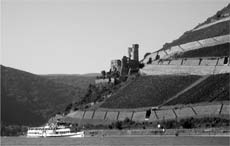 |
Castles, wine, and whatnot.
click images to enlarge |
So it was official, we were moving to France. My wife Valerie had found a new job there, near her parents’ place, we had found an interesting house to rent for a while, and we were pretty happy to be making the change. I was alone in our apartment in Cologne, boxing up our worldly possessions, but there was one thing nagging at the back of my mind: I had spent many happy days paddling the Rhine, but had for whatever reason never paddled the best bit, roughly between Mainz and Koblenz.
This was the Rhine Gorge, the part with the castles every couple of hundred meters or so, with all the south-facing slopes covered with vineyards, the stretch that has launched millions of postcards and half of the tourism posters on the walls in travel agencies, the stomping grounds of Julius Caesar and his legions, Charles the Hammer, Seigfreid, the dragon Fafnir, fair maidens that sing sailors to their deaths on hungry stones, of Charlemagne's, robber barons, and today, legions of tipsy tourists in search of the perfect glass of Liebfraumilch (the milk of our Beloved Lady!?). And of course there had been the usual concerned, almost strangled, looks from a few German friends when I mentioned paddling on the Rhine, doubly so for this stretch.
So one bright Friday in late September, I tossed my folding kayak in the back of the car, and headed off to Bingen, a pretty little wine town on the river where it enters the gorge.

Bingen on Rhine, copper plate print by Matthäus Merian, 1655 |
I was a little late getting started, but was helped out time-wise by some mods I had made on the folding s-o-f canoe, mainly using hinges with removable pins to join the sides to the stem and stern. The boat used to take about an hour to put together, but I now have it down to about 20 min.
I pulled off into the stream and was almost immediately confronted by Reality, or rather the Reality, a huge bulk carrier.
Reality |
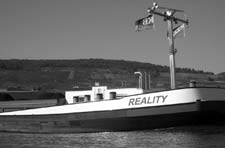 |
I was really going to have to pay attention on this stretch: the usual amount of traffic is crammed into what is often a very narrow part of the river.
But the funny thing was just how uneventful the trip turned out to be.
The Loreley was flat water with barely a ripple, the Hungry Stones turned out to be just a wee bit peckish: the 19th century German engineers who set out to make the Rhine safe for shipping were an enormously competent bunch. Mostly, except for some waves set off by shipping chopping up a narrow channel, and dodging the odd ferry, it was like paddling on a long narrow lake that was moving at about 5 mph.
The weather was perfect, the landscape lived up to its reputation, the towns were idyllic, I had a couple of glasses of very good white wine during stops. But aside from that, absolutely nothing happened. I spoke to almost nobody, nobody came up to ask about the boat, everything was designed to move people past the scenery as fast and with the minimum fuss as possible, and it worked.
I have noticed this before. Usually touristy areas are that way for a reason -- some especially nice quality that brought people there in the first place, but once the tourist infrastructure is in place, unless the place is a big city like Paris or New York, where the city dwarfs the influence of tourists (mostly anyway) you tend to loose all contact with the heart of the place.
Normally on a canoe trip I get a chance to stretch my legs and talk to some folks and dip into the life along the river. It helps a lot to have a self-made and funky boat, but anyway it is much of the interest of the trip for me.
I would bet if I had been poking along some stretch of a tributary somewhere nearby I would have seen fewer marvels, but had much more fun. Here it was like paddling through a diorama with good wine and crappy food.
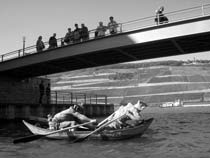 |
Wooden men rowing a steel boat in Bingen. |
There was one thing that I got to thinking about though. It has been popular lately to speak of “the tragedy of the commons” as if it were somehow inevitable and far more widely applicable than it actually is. But here on the Rhine, you had an example of the opposite: sort of a “tragedy of ownership,” or the “too many stakeholder” problem.
There used to be many more castles than there are now, actually. Most of them were destroyed by Napoleon, and not just because he enjoyed that sort of thing. In fact the problem was that over the centuries, just about every Tom, Dick, and Harry with a “von” in their name and a castle, decided that they had the right to collect tolls on the boats passing by. Over time this pratically strangled the trade on the Rhine and cost the region untold economic benefits for centuries. But a few Tom von Whereevers got rich, at first at least.
You could see this best in Cologne when Napoleon arrived. The Cologne Cathedral was started in about 1250, moved along well for a century or so, but then trade along the Rhine declined so much that they pretty much abandoned work on it for more than 400 years, until the Prussians moved in with something to prove in about 1870, and finally finished it about 20 years later.
But anyway, it was an extraordinarily pretty and interesting diorama, so here are some photos. Not a whole lot to write about that you can’t find on Wikipedia.
The Mouse Tower |
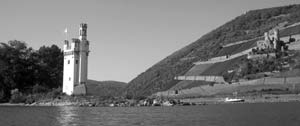 |
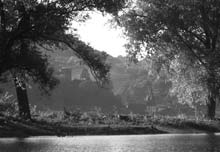 |
Idyllic little Rhine town. |
Boppard on Rhine, with vineyards on slopes above town. |
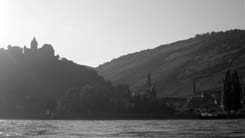 |
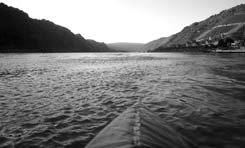 |
In midstream after Boppard. |
Pfalzgrafenstein, a ship-shaped castle on an island in mid-river. It has stood up to 800 years of floods... |
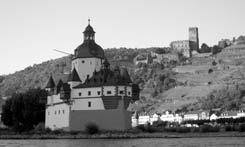 |
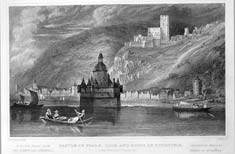 |
Castle Pfalzgrafenstein, located in the middle of the Rhine, and Castle Gutenfels above the village of Kaub on the opposite bank. The similarity between the photo and the engraving was not intentional, but good to see. |
| One of an endless stream of honkin’ big container boats. |
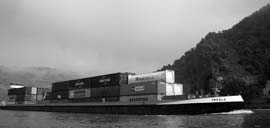
|
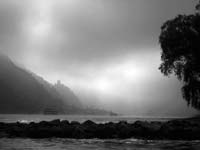 |
Morning on the second day. |
The Loreley |
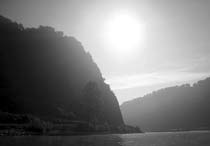 |
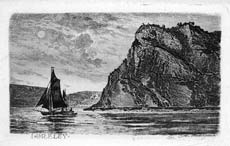 |
Nice old gaffer river boat. |
Victorian soft porn, ahem, art, of a buxom maiden posed as the Loreley. |
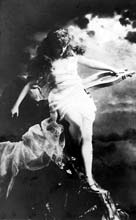 |
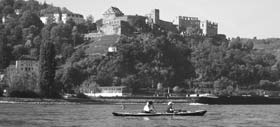 |
A retired couple on the river. They said they made the trip from their home in Mainz to Koblenz at least once a month throughout the year. They had a nice carbon-fiber-framed folding double, and from the faded deck, it looked like they weren’t exaggerating. |
Boppard: another pretty, and famous little wine/Rhine town. |
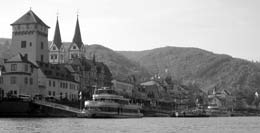 |
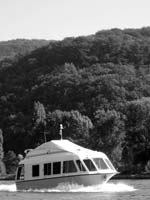 |
Bolgeresque camper boat. |
A modern side wheeler. I noticed that in addition to the side wheels, she had a normal propeller under the stern. It seemed like the sidewheels were also driving the boat and not merely for show, but it was hard to tell exactly. |
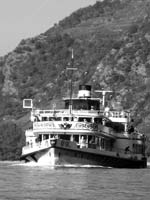 |
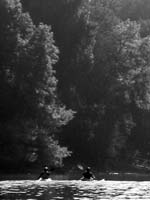 |
Kayak class, Koblenz |
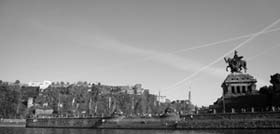
Deutsches Eck, and Kaiser Willi. This peninsula in Koblenz is the “spiritual home” of the Germans, the place where the Mosel River joins the Rhine. Deutsches Eck means “German Corner” and after the Prussians under Kaiser Wihelm and Otto von Bismark unified Germany in the early 1870s, they set off on an ambitious building program that included finishing Cologne Cathedral, and planting equestrian statues of the new Kaiser all over the place, including here, though it would be hard to think of a less appropriate place. Time has not softened the oppressive, overbearing feel of the monument, and Prussia is a long way, both in miles and spirit from the Rhineland. |
***** |

